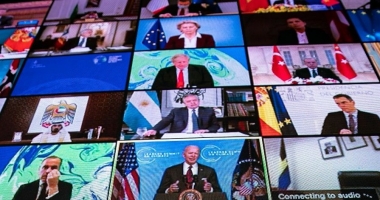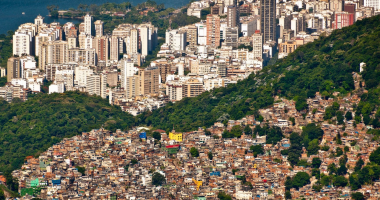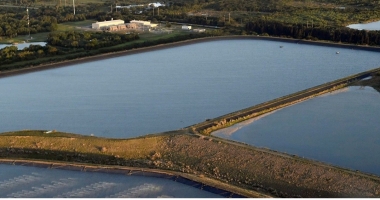Climate, Health and Equity Brief
Denis Hayes on the Evolution of Earth Day
April 21, 2020

As part of our weekly Climate, Health & Equity Brief, we’re pleased to share a periodic interview series with leaders working at the intersection of climate change, health and equity. This month we spoke with Denis Hayes, President and CEO of the Bullitt Foundation and founder of the Earth Day Network.

You are well known for being the founder of the Earth Day Network. Since the first Earth Day on April 22nd, 1970, how would you say that attitudes and participation have evolved in the fight to protect our planet?
Prior to Earth Day, environmental concerns were narrowly targeted. Some people cared deeply about the threat of DDT to birds, including the bald eagle. Some cared a lot about the devastation caused by the Santa Barbara oil spill. Residents of Pittsburgh, Gary, and Los Angeles were upset to learn that just breathing their air was like smoking two packs of cigarettes a day. The residents of Cleveland were angry that the Cuyahoga River kept catching on fire. What Earth Day did was tie all these concerns, and others, into a coherent package—the environment—with a shared set of values. All those different groups then supported the Clean Air Act, Clean Water Act, Endangered Species Act, Toxic Substances Control Act, etc.
Today, millions of people won’t vote for a political candidate who is anti-environment. They choose their cars, install solar panels, buy organic food, avoid red meat, prefer natural fibers in their clothes, and even limit the number of children in their families for environmental reasons. People have come to believe that they have a fundamental right to a clean, healthy environment—a concept that just didn’t exist when I was young.
As President of the Bullitt Foundation, you work to move cities and communities toward sustainability and climate resilience. In what ways is that work interconnected with health and equity issues?
Equity was a big issue in the first Earth Day. Major civil rights leaders gave speeches about rats and lead paint as environmental issues. It was already clear that poor people—who lacked political clout or the money to hire high-priced lawyers—suffered the worst environmental degradation. Poor people got the toxic waste incinerators and the 10-lane freeways in their neighborhoods. The first Earth Day aspired, and was fairly successful, in combining concerns for equity, justice, and peace in Vietnam with concern for pollution, biodiversity, and public health.
Over the decades, however, a split evolved. Poor people and people of color became understandably focused on crime, lousy housing, poor health care, food deserts, police brutality, and other urgent threats, and environmental groups—grown and funded through direct mail—became whiter and more middle class.
As part of the Bullitt Foundation’s emphasis on human ecology and the urban environment, we have placed great emphasis on what we term JEDI goals — justice, equity, diversity, and inclusion. In many ways, European cities have become models for environmental sustainability, with their dense, vibrant downtown areas; efficient, convenient, attractive public transportation; public markets for fresh, local produce. But many of those European cities have seen their poorer citizens pushed to the perimeter. Unlike American cities, where the suburbs tend to be wealthy, European suburbs are often ghettoes. We have tried to learn from that experience, and we work hard to make our region’s cities fully integrated across classes. Our grantees include a large number of groups that focus mainly on social justice and equity, and we fund them to become engaged in urban environmental issues. Some of them have proven to be among our most successful advocates on goals from solar energy to air toxins.
COVID-19 is in many ways reshaping how the public views global issues and our interconnectedness—how do you think this will impact climate change?
My optimistic impulse is to say that it will help us to understand that we cannot successfully wall ourselves off from the world. Some topics, like COVID-19 and climate change simply cannot be solved by any one country acting on its own. They demand a coordinate global response. My pessimistic side says that that has been obvious for decades in the climate arena, but the world has recently experienced the greatest surge of ultra-nationalism in my lifetime, from the US to Turkey, Russia, Philippines, China, and India. The immediate answer for COVID-19 is to shelter at home with your families, and avoid social interactions with your colleagues and neighbors. Avoid buses and light rail. Don’t go camping or hiking.
In general, my impression is that when crises leads to institutional changes, those changes endure. 9/11, for example, led to dramatic changes in airport security, building access, ubiquitous cameras, and a generalized loss of privacy that continues to grow. Pearl Harbor led to the creation of the greatest military-industrial complex the world had ever see, and it continues today. So far, climate change has mostly led to a huge number of studies and conferences (whereas what’s needed is the total replacement of the world’s fossil fuel infrastructure). Time will tell what enduring impact, if any, COVID-19 will bring. Will people be hesitant to go to athletic stadiums and movie theaters? Will science develop an effective vaccine so that life returns to normal? At a minimum, I hope society will come out of this recognizing that everything in the world is not just a matter of opinion; that expertise is actually very important; and that America will begin once again to invest heavily in science education and basic research.
What is your greatest hope when it comes to the future of climate change?
My greatest hope is that we will invest heavily in a set of interrelated measures to increase the efficiency of all buildings by 75 percent; to electrify all transportation (including high-speed rail); to rapidly phase out all use of coal and virtually all use of oil and gas; to shift the electrical system into a collection of solar, wind, batteries, ultra-capacitors, flywheels and other storage, and smart microgrids; to return industrial production to America using leapfrog technologies, super-efficiency, circular economics, and economies of scale to be globally competitive. I would like my granddaughter to experience a healthy, unpolluted world, predicated upon learning from a billion years of beta testing by Mother Nature.
Your biggest fear?
My greatest fear is that we will continue to delay until we have passed some crucial tipping points. At some point, the vaporization of methane hydrates become a self-reinforcing cycle. At some point, the reduction of the earth’s albedo may become irreversible. At some point, ocean acidification will demolish the bottom of the food chain. We know many such tipping points exist; we don’t know when they will be reached; and avoiding them will require joint commitment by the majority of nations on earth.
What would you encourage others to do to make an impact in the fight against climate change?
First, walk your talk. Pay attention to the climate impacts of your housing, transportation, diet, choice of occupation, stock ownership, and banking choices. But also recognize that, while individual actions are important for your personal integrity, they cannot solve the climate emergency. That will require action at the local, state, national, and international levels. Exercise your responsibilities. Make sure that the White House and the US Senate are never again dominated by science-ignorant climate deniers. For 40 years, the official response to climate change has mostly consisted of studies and conferences. Had we gotten serious in 1980 instead of throwing in the trash Jimmy Carter’s goal of 20 percent renewables by the year 2000, we would have mostly solved the problem by today, rather cheaply and painlessly. Having squandered 40 years, solving the climate crisis will no longer be cheap or painless. But it remains essential.

)





